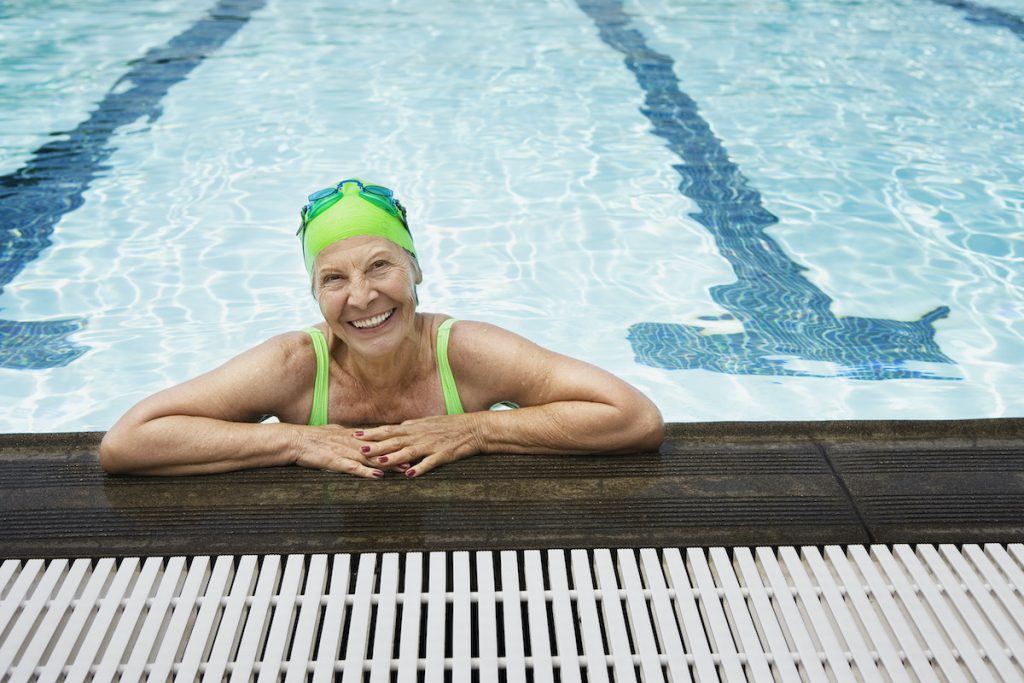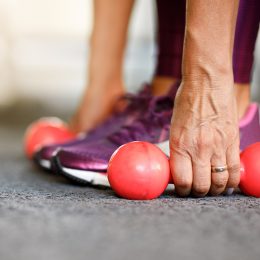10 Tips for a Better Swimming Workout
Swimming is one of the best exercises for older adults — and you’ll be much better at it after you read this.

Swimming may well be the perfect lifelong sport. It’s a low-impact, joint-friendly, sustainable way to stay in great shape at any age. And it can improve longevity and quality of life.
If you’re ready for a challenge after you’ve mastered the basics of swimming — or after a prolonged hiatus — there are a few things to keep in mind before diving into the deep end.
First, give yourself time to get into swimming shape. Endurance training increases the ability of your muscles to use oxygen and nutrients more efficiently. A SilverSneakers Circuit class is a good option. It combines upper-body strength work — which you’ll need for the arm movements —with low-impact cardio. SilverSneakers Circuit is offered both in-person at participating fitness locations or online with SilverSneakers LIVE.
Second, though swimming generally boasts very low injury rates, overuse injuries — such as the dreaded swimmer’s shoulder — can waylay you if you overdo it before your body has time to adapt. For the first month or so, concentrate on refining your technique. As with all exercise, good form is key. You can focus on adding intensity later.
Third, our understanding of proper technique has changed over the years. Two forces impact your speed in the water:
- Propulsion: How much force you can muster to move forward
- Drag: The resistance that water exerts on your body
Minimizing drag will pay much greater dividends than trying to increase power, so that should be your priority.
With all this in mind, here are 10 ways you can optimize your stroke and your swimming workout.
Ready for a pool workout? Find participating SilverSneakers fitness locations here. Tip: Use the “Filter” tool and click “amenities” to narrow your search to locations with pools.
Swim Tip #1: Make Like a Missile
Try a quick experiment: With your hands by your sides, push off the wall underwater, and glide until you come to a stop. Now try this again with your arms outstretched about shoulder-width apart and your head tilted slightly upward like Superman flying.
Now, repeat a third time while contorting your body into the longest, straightest, thinnest missile shape you can achieve. Overlap your hands, extend your arms and fingertips as far as possible overhead, squeeze your biceps over your ears, and keep your head down.
As soon as you push off, bring your legs together with knees straight, and point your toes to eliminate even a slight rudder effect.
You’ll be amazed at how much farther the same amount of effort will take you in the third position.
Recommended reading: A 20-Minute Cardio-Interval Workout You Can Do in the Pool (No Laps!)
Swim Tip #2: Go Ahead and Look Down
Back when I swam in college in the 1970s, coaches advised freestylers to keep our heads high in the water and look forward so that — the theory went — they’d hydroplane on the water.
They were wrong. Coaches now realize that lifting your head causes your hips to drop, forcing you to move through the water like a plow. It’s far better to keep your head down, and your eyes trained on the lane line. This will help you swim horizontally, cutting drag, and placing much less strain on your neck and lower back.
Swim Tip #3: Roll with It
Imagine a race between a river barge and an America’s Cup yacht. The barge will never win because it’s designed to plow through the water in a completely flat position. The yacht, on the other hand, spends most of its time slicing through the water tilted to one side or the other, lowering its hull profile and greatly reducing drag.
This same concept applies to freestyle. Not only does a good side-to-side body roll cut drag, but it allows you to use your core muscles in a way that adds considerable power to your arm pulls.
To practice rolling, try this:
- Extend your right arm forward as far as possible, place your left arm flat against your torso, then push off the wall on your side.
- Your left shoulder should point toward the ceiling, and your right shoulder should be aimed toward the bottom of the pool.
- While maintaining this position, kick eight to 10 times.
- Then pull your right arm through the water, rolling your body to the opposite side as you pull.
- Now extend your left arm forward like a marlin’s bill. Kick eight to 10 times here, and repeat.
When pulling, concentrate on directing your power straight backward. Many rookies squander energy by pushing down on the water during the initial phase of the stroke, then pushing upward during the final phase. All this does is make you bob up and down — not move forward.
Swim Tip #4: Control Your Hands
Keep your hands about shoulder-width apart throughout the freestyle pull. Imagine there is a vertical line down your body, separating your right side and left side. Many swimmers, especially while breathing, allow their hands to cross over this vertical line. This causes you to fishtail side to side, subtracting from forward progress and dramatically increasing drag.
Swim Tip #5: Stop Kicking So Hard
A good freestyle kick not only helps to balance your body and maintain good position in the water, but it can significantly increase speed if executed correctly.
One common mistake: overkicking. Small, quick kicks generate almost as much force as large, powerful ones while creating much less drag.
Try this:
- Point your toes
- Don’t bend your knees too much
- Try to keep your legs within the slipstream of your torso
Swim Tip #6: Loosen Those Ankles
You don’t have to have flipper-size feet to have a great kick. Efficiency here, research has shown, often has more to do with ankle flexibility than foot size.
If you’re coming to the pool after years of land sports — running, biking, tennis — chances are your ankles are tight and prone to a right-angle position. To loosen them, wear a pair of flexible swim fins. Not only will it give your legs a great workout, but over time your ankles will become much more flexible.
Plus, check out these tips on ankle health.
Swim Tip #7: Keep the Noise Down
One antidote to muscling your way through the water is to concentrate on making your stroke as smooth and “fish-slippery” as possible. To do this, practice swimming quietly. The sounds of splashing and thrashing indicate wasted energy.
Subscribe to our newsletter
It's quick and easy. You could be one of the 13 million people who are eligible.
Already a member? Click to discover our 15,000+ participating locations.
Follow Us
Swim Tip #8: Up the Challenge Gradually
The three basic components of swim training are:
- Duration: How long you swim
- Intensity: How hard you go at it
- Frequency: How often you do it
A good rule of thumb for keeping your workouts challenging but safe is to choose one of those components each week and increase it by 10 percent.
The Centers for Disease Control and Prevention currently recommends adults get 150 minutes of moderate-intensity aerobic exercise or 75 minutes of vigorous aerobic activity every week. A reasonable goal for most swimmers is to build up to three to four sessions a week, 30 to 60 minutes per session.
If you can do more, great. Less is also okay, especially if you do a variety of cardio workouts or SilverSneakers group fitness classes. Just find the amount you can sustain for the long term.
Once you establish your swim routine, add some short, fast swims into the mix, alternating bursts of speed with rest on a one-to-one ratio.
For example, 30 seconds of sprinting followed by 30 seconds of rest, then repeat eight times.
Swim Tip #9: Take Tomorrow Off
As for frequency of swim workouts, it’s important to remember that rest days are key to making physical gains, especially the older we get. Back in my college days, it was normal to swim two practices a day, six days a week. Nowadays, four one-hour swim practices per week have proven just right for me, helping me to preserve my fitness level without breaking me down.
Swim Tip #10: Team Up with a Friend
If you’re serious about improving your swimming, there’s only so much you can accomplish solo. Fortunately, coached workouts and stroke instruction are available nationwide to aquanauts of all ages and abilities.
To find a team in your area, check with your local community or recreational center. You can also check out this list from U.S. Masters Swimming. One of the greatest myths about Masters Swimming is that you have to be good to join. Precisely the opposite: Joining is the best way to get good. And the value of supportive teammates to keep you motivated may be the best benefit of all.
*The author is a champion masters swimmer and award-winning health writer.
Take Your Favorite SilverSneakers Classes Online!
SilverSneakers members can access live fitness classes and wellness workshops through SilverSneakers LIVE. See the latest schedule and RSVP for classes here.
Not a member? If you have a Medicare Plan, it may include SilverSneakers — at no additional cost. Check your eligibility instantly here.
Not eligible for SilverSneakers? You can still get 200+ free SilverSneakers On-Demand videos and stay in touch with us by creating your online account.





